In this Semrush review, I will be testing one of the best-known SEO tools.
I’ll discuss how this compares in terms of:
- Competitive analysis
- Keyword research features
- Rank tracking
- Analysis of backlinks
- Link building tools
- Site audit
- Ad builder
- Price and price-performance ratio
- Support
………and more!
I will start with an important question …
What is Semrush?
Simply put, Semrush is a product that helps you optimize your website for search engines. Created in 2008 by Oleg Shchegolev and Dmitry Melnikov, it now has a very large user base – over 6 million users, according to the company – and is one of the most popular SEO tools available today.
Semrush works by giving you a lot of information, which you can use to:
- create new web content that can attract traffic
- identify opportunities for link building
- adjust the technical aspects of your site’s content so that it achieves better search rankings.
For example, Semrush may provide you with keyword suggestions (based on the phrases you enter) that can be used as a basis for writing blog posts that may perform well in search results.
It can also tell you how difficult it will be to rank specific search phrases.
And it lets you do an “SEO audit” on your website to see if there are any technical improvements you can make to it that will help you get better search results.
This is just the beginning though – there are many other features provided by Semrush that are designed to help you improve your site’s position in search results. I’ll go through them in detail below, highlighting all of their pros and cons.
Competitive analysis:
One of the great strengths of SEMRush is that it gives you very useful insight into your competition’s SEO and advertising strategy. Moreover, it is very easy to do it. Simply log into SEMRush, enter your competitor’s URL, and choose the country you want to see Google data from.
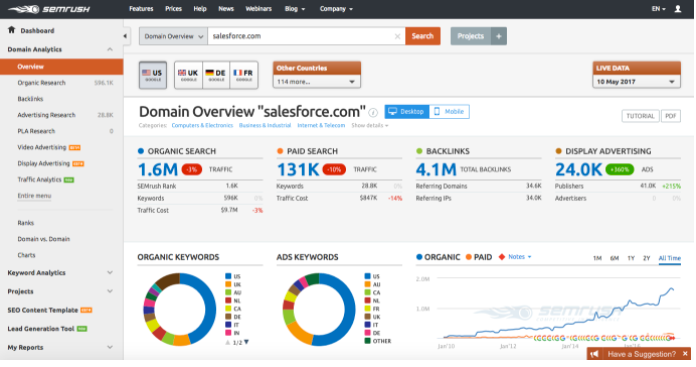
You then see some pretty visuals showing the growth of both organic and paid website visitors. In addition, the analysis provides an estimate of the number of monthly paid and organic visits.
SEMRush estimates these numbers by multiplying the click-through rate (CTR) of the domain by the keyword volume and dividing by the number of days in the month.
To find out where this traffic is coming from, just click on the number. For example, we can see that SEMRush estimates that Salesforce.com receives 1.6 million visitors to its site through organic search.
Then when we click on that number, we see the exact keywords that are driving that traffic.
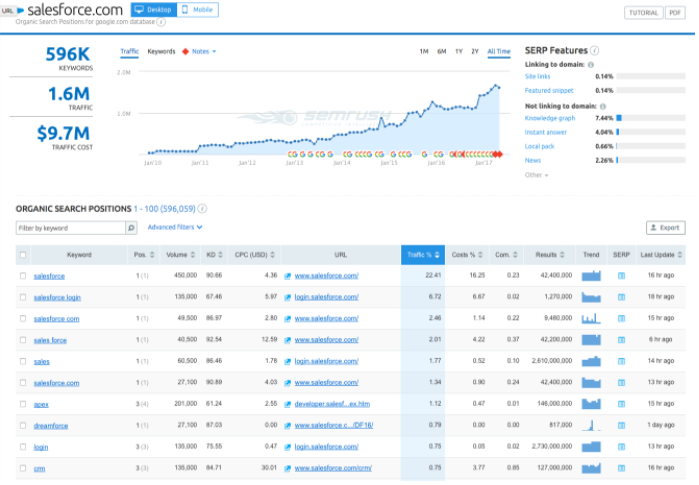
You can sort these keywords by position, volume, keyword difficulty, cost per click (CPC), the share of traffic directed to the website by the given keyword, competitive density, and search volume trend. There is also a link to the keyword’s SERP.
You can also dive into paid domain traffic and you will get all the same data as you do organic traffic. By clicking on it, you can see which terms your competitor has prioritized in their organic and search campaigns.
For example, if you click on backlinks, you can see where your competitor is getting their links from. Also, you can see graphs showing the types of backlinks and the number of referring domains.
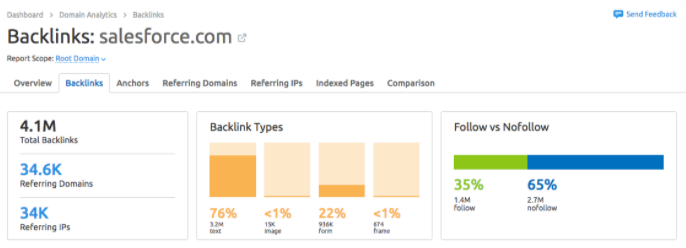
By scrolling down we can see the backlink URLs along with the page score, trust score, anchor text, number of external and internal links, link type, and date when SEMRush discovered the link.
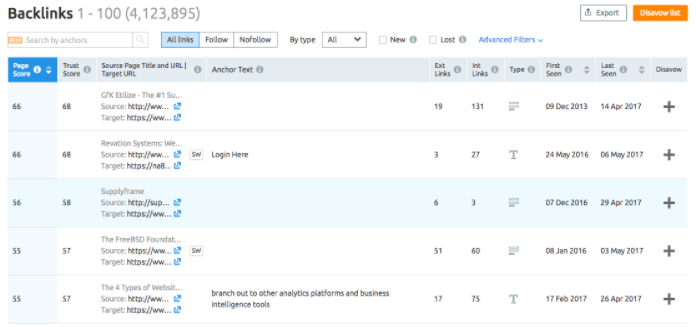
Additionally, by browsing these links, you can spot opportunities to link for your own site. Additionally, you can take advantage of the SEMRush backlink comparison tool to see how you are doing compared to five of your competition.
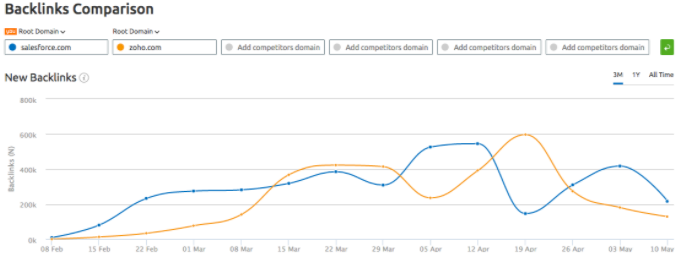
After you have gathered all of this valuable competitive data, the next step is to figure out what to do with it. To start outperforming your competition for relevant keywords, you need to analyze the pages they rank with and try to produce something even better on your own site.
Consider competitive density, competitor domain strength, and keyword difficulty to determine what it will take to rank for each term. You will need to do a bit of awareness to get those valuable backlinks and that could mean using an age-old tactic like guest blogging. SEMRush gives you the competitive insights you need to develop your competitive SEO strategy, and then track your progress.
Keyword research in Semrush:
Besides competitor analysis, SEMRush is a valuable tool for conducting your keyword research. The software analyzes over 120 million keywords and 39 million domains, making it an ideal starting point for keyword research. Just type the term you want to rank for in the search bar.
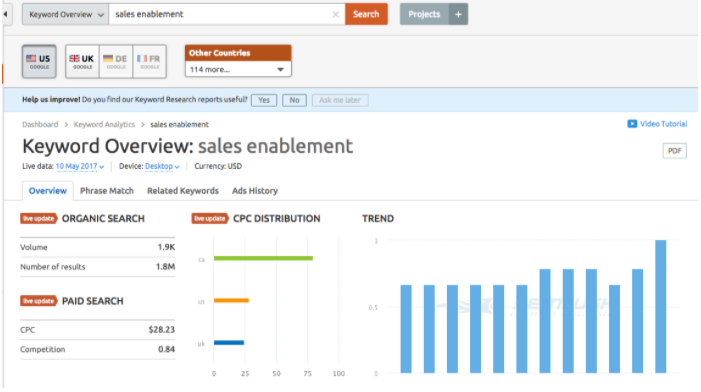
This displays an overview of keywords displaying data such as search trends, CPC, and organic search volume. For example, scrolling further down the page, you see phrase match keywords, related keywords, organic search results, and ads that appear for the term you entered.
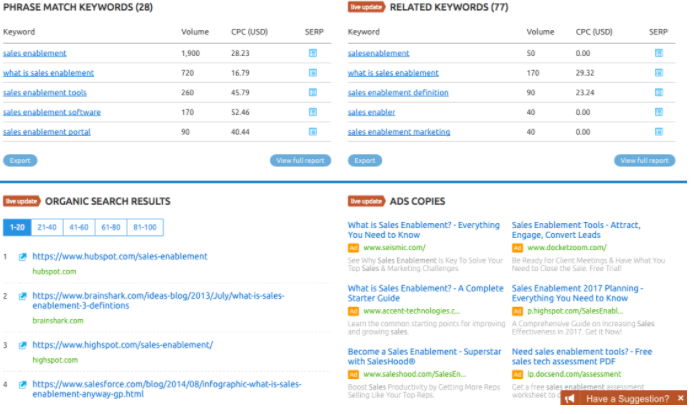
Clicking on the match keywords or related keywords takes you to the full report where you can filter and sort by volume, keyword difficulty, CPC, competitive density, and the number of reports.
You can also export this data to an Excel or CSV file. You can consider expanding your keyword targets by typing some of the related keywords into the search bar, which will bring up a whole new list of related terms. SEMRush gives you all the data you need to decide which keywords to target.
There is some really valuable data here to help you plan your PPC campaigns. You can view the CPC by country and see the competition for each ad. SEMRush also shows you the ad content of existing ads, which can also provide you with ideas for your own ads if you go the PPC route and help you understand which ads are working.
SEMrush Content Marketing Toolkit
In addition to providing keyword research tools, Semrush also offers you a suite of content marketing tools (provided you are on a “Guru” plan or higher).
These allow you to:
- identify new topics to write about
- audit your existing content from an SEO perspective
- identify the keywords that your competitors use in their publications
- monitor mentions of your brand.
My favorite feature in Semrush’s Content Marketing Toolkit is the ‘SEO Writing Assistant’ which allows you to copy and paste the content into Semrush for review (you can also write a copy in Semrush and get tips in real-time).
Once you do this, you get suggestions about ways you can improve its performance in search results. These include incentives to increase or decrease the word count; Recommendations that you add some keywords to your text; And warnings if your content looks like it has been scraped from other sites.
However, it would be nice that you could just paste a URL from your site and get these suggestions – the copy / paste thing is a bit annoying.
How to steal my competitors' traffic?
Rank tracking:
Rank tracking is the process of monitoring your website’s performance in the search engines for a particular keyword over time.
Setting it up in Semrush is easy – you go to its status tracker section, enter a domain name and the keyword you want to track, and you get a report that shows that your site currently uses those keywords How is ranking for. .
As time passes and more and more data on your site is transmitted to Semrush, you will be able to track the progress of your attempts to rank higher for the phrases you have chosen.
You can also enter competitor website data in Semrush’s position tracker tool, which allows you to compare (again, over time) how your site is performing against your competitors for the chosen keywords . And finally, you will receive regular email updates on your rank tracking progress.
Overall, the rank tracking functionality in Semrush is strong – no complaints here.
Backlink analysis:
The backlink is one of the two most important search ranking factors (content being the other).
So having a thorough link building strategy is no less than essential.
And that’s where the SEMrush Backlinks tool comes in. This is a regular backlink checker with a few additional features (which you might not necessarily use).
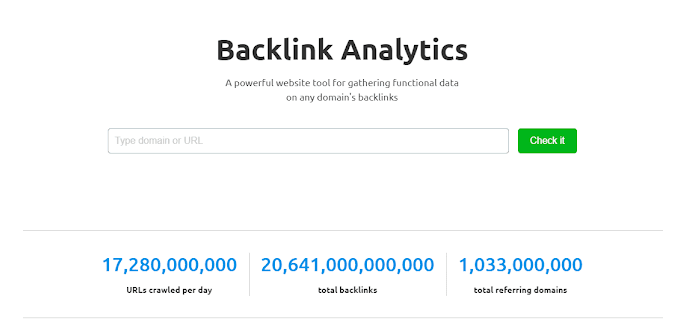
The tool helps you perform in-depth link analysis – right FROM checking inbound links and referrer domain geolocation to looking for anchor texts and knowing the type of backlink (doFollow or noFollow).
It also helps you identify the quality of incoming backlinks through different variables.
This is extremely important today when the quality of the backlinks is more important than the quantity.
Therefore, if you receive backlinks from spam-type sources, you can monitor them and then disown them.
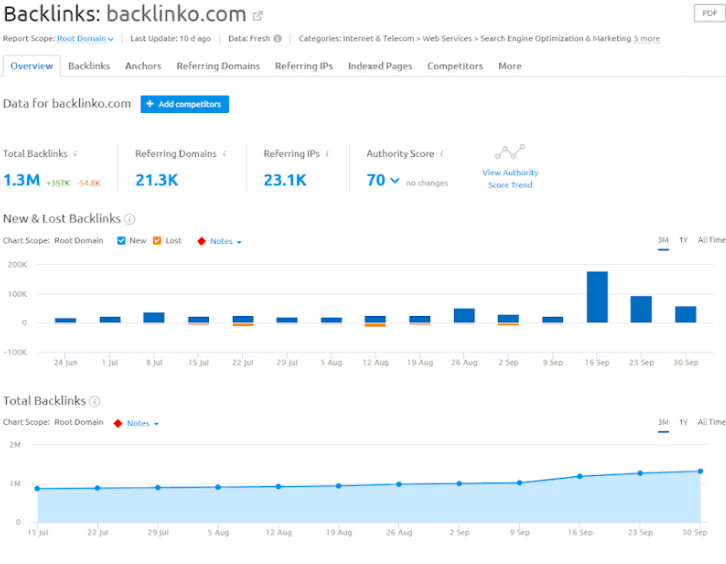
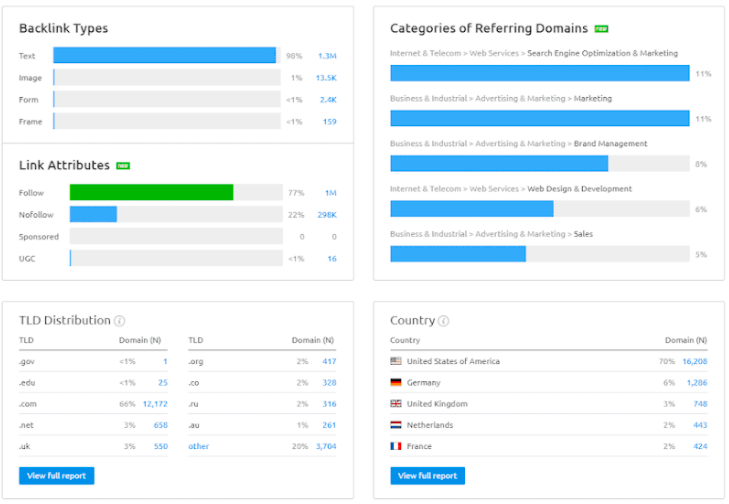
With the SEMrush Backlinks tool, the strategic part of link building becomes much easier.
Link building tools:
One of the most notable features of Semrush is its link building tool.
As mentioned above, link building – the process of building links between other sites and yours – is absolutely vital to the success of any SEO project, as search engines usually reward sites with more. of links pointing to them with higher positions in the search results (as long as the links in question are on relevant high-quality websites).
Semrush’s link building tool works by
- determine who your competition is and what they rank for
- review your site content
- asking you which keywords you want to rank for
then display a list of “potential” websites that he believes are worth approaching for a backlink or guest post opportunity.
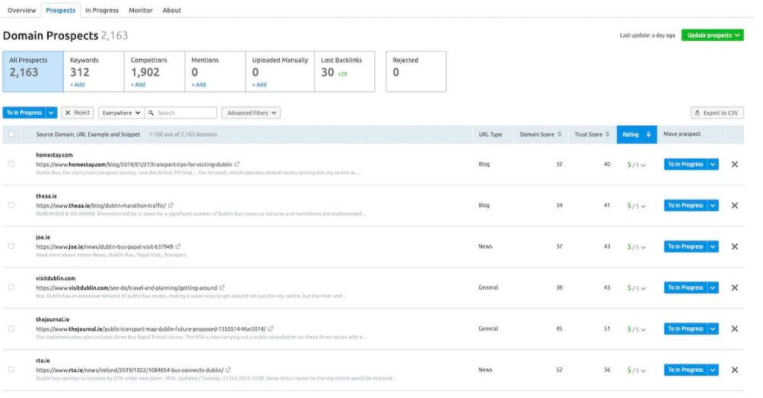
Not only that, but it provides you with extremely useful tools to do so. You can connect your mailbox to Semrush and send outreach emails from the tool.
You can then keep an eye, like the CRM, on the progress of each approach.
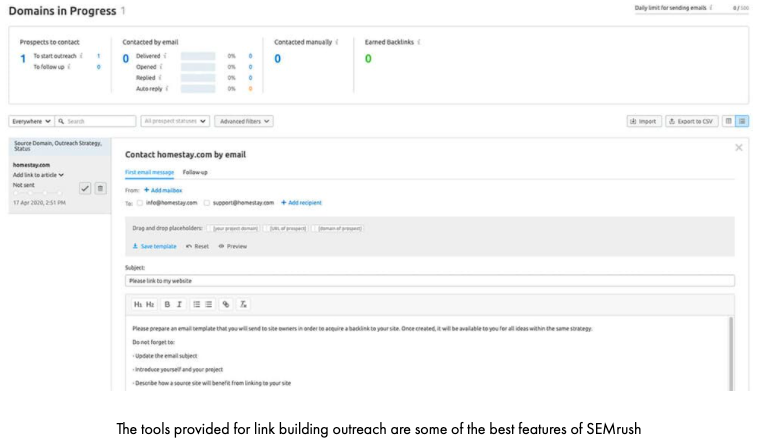
If that wasn’t enough, where possible, Semrush even provides you with email addresses for each website and the option to save an outreach email as a reusable template (see screenshot below- above).
This all goes way beyond anything offered by Semrush’s main competitors in the link building department; and this is arguably the strongest argument for using Semrush on them.
Site audit:
SEMrush Site Audit is perhaps the most intensive and efficient SEO analysis tool.
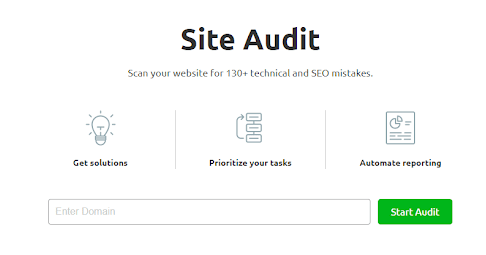
Its website SEO analysis reports return rich and actionable data to help you improve your site for better ranking.
This makes technical SEO pretty easy.
Check the general condition of your website.
Detect error pages, deal with duplicate content, optimize your internal / external links, optimize HTML tags, fix broken links and images, and solve various other issues.
Once with the report, make improvements to your site, then run the audit again. The tool will keep track of all the improvements you have made and the SEO progress you make.
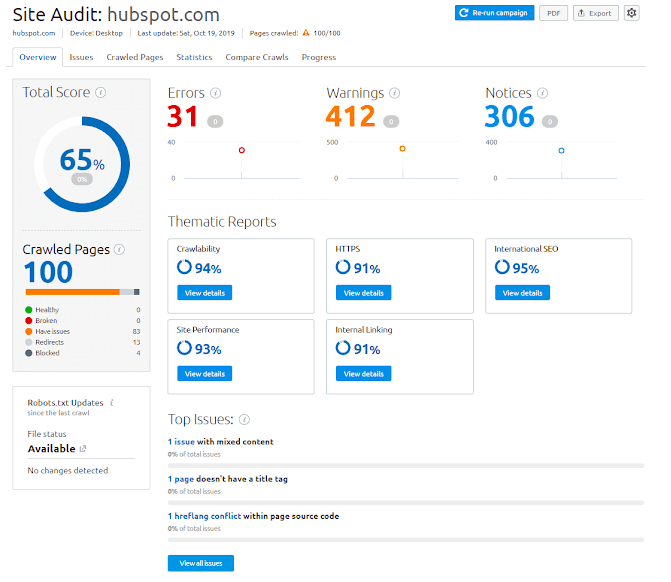
SEMrush Site Audit also helps fix hreflang, ensure the site is secure, and there are no AMP implementation issues.
Overall, its SEO analysis reports are quite comprehensive – very good at improving your site and boosting its rankings.
Ad builder:
If you’ve never run any ad campaigns before, this one will be a complete winner for you.
SEMrush Ad Builder makes creating ad campaigns quite fun, easy, and convenient.
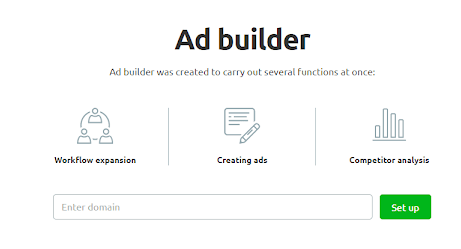
First, do some research on your competitors and industry leaders; the type of ads they run and how they generate results.
Know their advertising profiles and the keywords they use. Even get their ad template that you can copy.
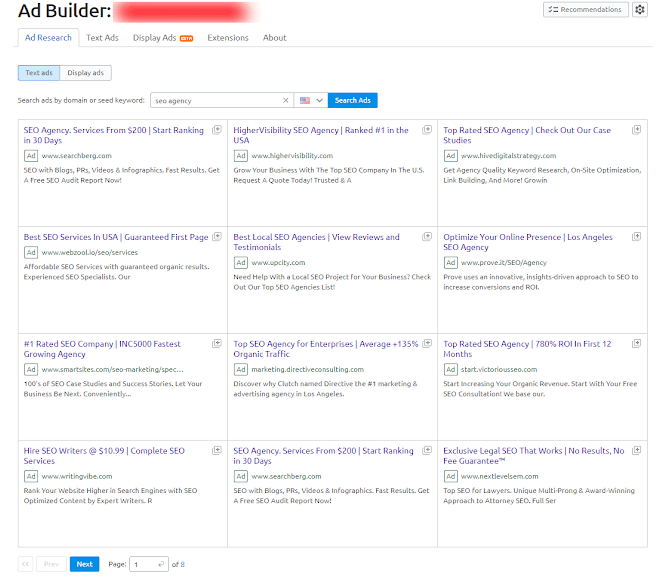
Then, SEMrush Ad Builder provides you with a user-friendly interface to create ads efficiently. He would give you basic advice and leave you prompts if you do something wrong.
In the same interface, you can also create relevant extensions, including sitelinks, teaser, snippet, and callout.
Preview how this ad will look to your audience in real time.
Additionally, while I am against (wasting money on) Google Display Network campaigns, SEMrush Ad Builder helps you create display ads for the Google Display Network.
So if you think display ads are worth the investment, SEMrush even has you covered here.
Price and price-performance ratio:
This is an important question… How much does SEMrush cost?
Well, for starters, this all-in-one digital marketing tool doesn’t come for free.
However, they did a decent job in their plans to make sure there was something for every type of need.
SEMrush is available in four different plans:
- Pro
- Guru
- Business
- Enterprise
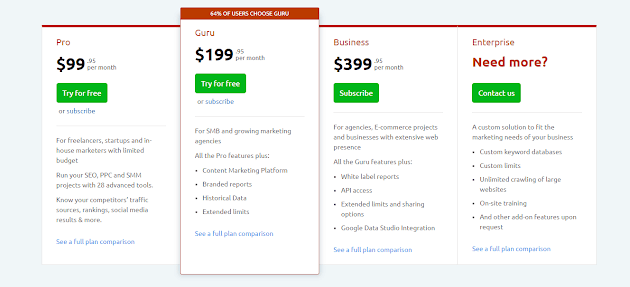
It’s important to note that if you want to check out Semrush before committing to a paid plan, a free trial is available – the standard version lasts for 7 days, but for a limited time you can access an extended 14-day program here.
In terms of comparing the length of this trial with those offered by competitors, it is better than Ahrefs’ offer (a 7-day paid trial) but less generous than Moz’s (a 30-day free trial). .
You have to enter your credit card details to take advantage of the trial, which – while common practice when it comes to SEO tools – is a bit boring.
The main differences between Semrush plans are:
- the number of reports you can run per day
- the number of keywords you can track per month
- access to content marketing tools
- access to historical data.
The more you pay, the more you get all of the above.
So it’s a good idea to start with the basic plan, master the tool, and then upgrade to suit your needs and requirements.
Don’t blindly jump on the business or Enterprise plan just because you can afford it.
Advantages and disadvantages of SEMrush:
If you’ve looked through the SEMrush features above, you must have found plenty of benefits. It is indeed an “all-in-one” digital marketing tool.
But then it also has a few cons too.
Here is a summary of all its advantages and disadvantages …
ADVANTAGES:
- The widest range of tools / features
- Lots and lots of data
- The best competitive analysis tool
- Clean and organized interface
- Flexible pricing
- Fast and reliable support
- Enough guides and DIY / troubleshooting documents





